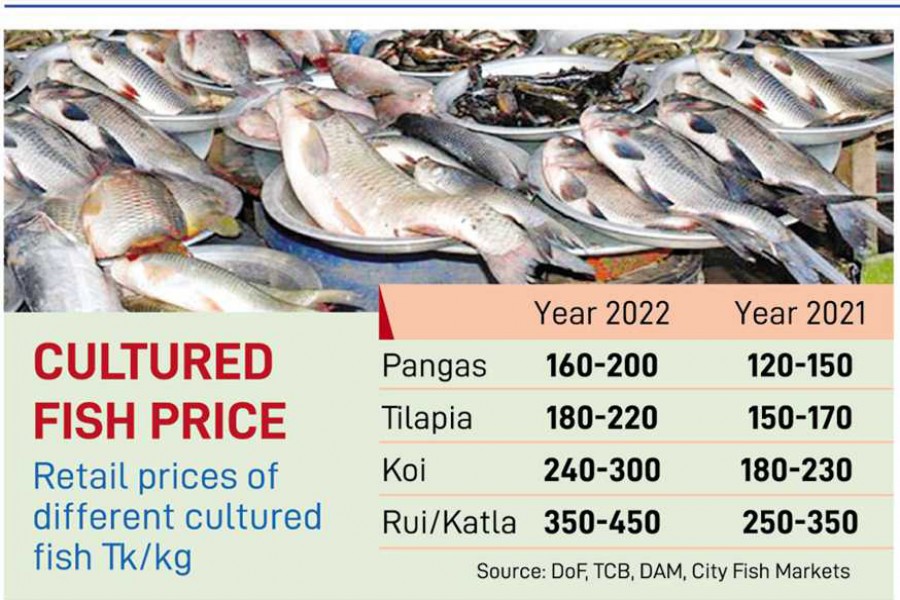Cultured fishes, a key source of protein for the commoners, became costlier by 30-40 per cent in the just-concluded year, an all-time high in prices of the fish in a single year, according to official data.
Cultured rui, tilapia, pangas, koi and other commercially bred fishes showed the record hike amid a skyrocketing trend in fish-feed price, triggering a drop in production of a few species, said insiders.
Prices of cultured rui and katla shot up to Tk 350-450 a kg depending on the sizes in 2022 marking the highest 40 per cent increase in a year, said the Trading Corporation of Bangladesh (TCB).
According to the state-run TCB, the surge is an all-time high considering any single calendar year.
Tilapia prices soared to Tk 180-220 per kg from Tk 150-170 a kg-a 30 per cent hike in a year.
Pangas, a cultured fish consumed mostly by lower-income group or poor, witnessed a 28-30 per cent hike as was sold at Tk 160-200 per kg in the second half of 2022, marking a 33 per cent surge on average, said sources at the Department of Agricultural Marketing (DAM).
Cultured koi also showed a 30-35 per cent hike in 2022 and sold at Tk 220-260 a kg, according to fish corners of different city kitchen markets.
"A 60-70 per cent surge in feed prices as well as a drop or stagnation in pangas, koi, tilapia production have contributed to such price hike," an official at the Bangladesh Fisheries Research Institute (BFRI) said.
He noted that output of the widely-consumed pangas fell by 21 per cent to 0.402 million tonnes in 2021 which was 0.51 million tonnes in 2017.
However, tilapia output remained almost static at 0.425 million tones, he said.
Monowar Hossain, a commercial fish producer at Singra in Natore, said feed price shot up to Tk 68-72 per kg which was Tk 30-35 one and a half years back.
He said pond owners are now producing high-value pabda, gulsha, rui and katla instead of pangas or tilapia as they could make 15-20 per cent more profits from their trade.
Farm economist Prof Gazi M Jalil said it is a matter of irony that millions of people in Bangladesh, the world's third largest cultured fish-producing country, couldn't source fish for their higher prices.
He said higher costs of feed and transportation mainly triggered an uptrend in prices of essential commodities in 2022 and fish was one of them.
Prof Jalil also said closure of many farms during coronavirus-induced lockdowns in 2020 and 2021 also caused a drop in the production of some fish species.
"The government should immediately take a plan to minimise prices poultry, fisheries and cattle-dairy feed to keep prices of protein items within reach of millions of poor and low-income people.
Consumers Association of Bangladesh vice president SM Nazer Hossain said the poor have severely been affected by cultured fish, boiler chicken and egg price hikes.
He said the protein intake by fourty per cent of poverty-stricken families in the country drastically declined in 2022 as their income dropped in the real term.
Bangladesh produces 4.6 million tonnes of fish annually of which cultured fish comprises more than 1.3 million tonnes, said the Department of Fisheries (DoF).
Bangladesh is the third largest aquaculture fisheries producer in the world, according to the FAO.


